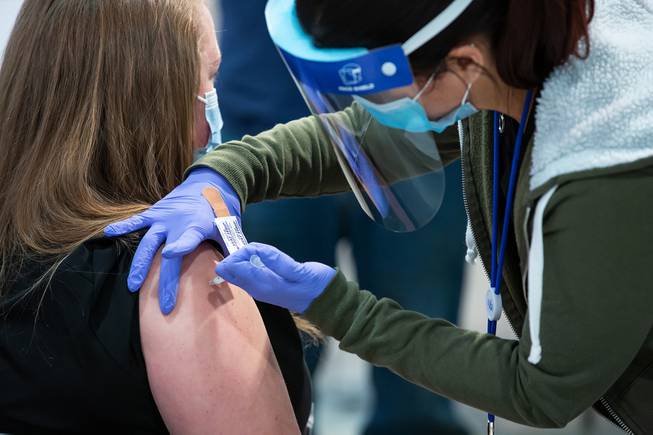
A healthcare worker with the Southern Nevada Health Department administers a second dose of the Moderna COVID-19 vaccine at the Las Vegas Convention Center, Monday Feb. 1, 2021.
Thursday, March 4, 2021 | 4:52 p.m.
RENO — Gov. Steve Sisolak has ordered flags lowered to half-staff in recognition of another somber coronavirus milestone: confirmation Thursday of the 5,000th COVID-19 death in Nevada since the pandemic began a year ago.
But the news came as otherwise upbeat health officials continued to report steady, significant improvement in slowing the spread of the disease statewide. Sisloak also said the state remains on track to allow local governments to begin taking control of setting-capacity requirements and other COVID-19 controls in May.
The 14-day moving average for daily new cases in Nevada has dropped from more than 2,000 in mid-January to 272 on Wednesday — the fewest since June 2020.
At 6.9%, Nevada’s positivity test rate for the virus is the lowest it has been since October and a dramatic improvement from a peak of 21.6% on Jan. 13.
“A lot of counites are showing a lot of progress on a daily basis,” said Kyra Morgan, the state’s chief biostatistician. She said 8% of all Nevadans now have been fully vaccinated and 15% have received a first dose.
Sisolak ordered flags flown at half-staff until sunset Friday, which marks the year anniversary of Nevada’s first confirmed COVID-19 death. The 5,000 deaths are among 259,069 total cases of COVID-19 reported in Nevada.
“As we acknowledge the scale of this tragedy that grips our state, I ask Nevadans to keep in your hearts those who have passed away and the families that have been affected by the virus,” Sisolak said.
The Democratic governor also released additional guidance for the transition of mitigation and management to local authorities that he first outlined in mid-February when he announced a gradual loosening of capacity limits on businesses and gatherings. The final step from the current 35% to 50% of capacity is set for March 15.
Leaders of the state’s COVID-19 task force stressed during a meeting Thursday that statewide mask requirements, social-distancing guidelines and other measures will remain in place despite the transfer of much of the enforcement responsibilities to local entities as early as May 1.
Nevada gambling regulators will maintain authority over capacities and other COVID-19 related rules at casinos and other businesses with gambling licenses, as will various state licensing and control boards for other industries and such institutions as hospitals, nursing homes and other health care facilities.
State COVID-19 Response Director Caleb Cage and others at the task force meeting were unanimous in urging Nevada to resist the temptation to follow other states that are dropping mask requirements or expediting full-scale re-openings.
“This is the absolute worst time to take your foot off the pedal for anything,” said Dr. Mark Pandori, director of the Nevada State Laboratory.
Cage said the task force will be meeting with individual counties in mid-March and April to help determine if the local plans they are developing will be ready for the transfer of general regulatory authority by May 1, and that likely won’t take place until later in several counties.
The governor must delegate the authority to individual counties based on the local plans, which must first be endorsed by the local health district or health board, the superintendent of the local school district, city managers within the county in cities with populations of 100,000 or more and the Nevada Hospital Association and/or Nevada Rural Hospital Association.
But once a county’s local mitigation and enforcement plan receives delegation of authority from the governor, the task force no longer will be required to approve future loosing or tightening of restrictions.
“It is not an approval process, per se,” Cage said. “One caveat for that, if throughout the process, we determine there are substantial deficiencies to a local plan in time to transition May 1, we would still reserve the right to work with that local government in order to ensure its fully prepared for delegation of local authority that will be coming their way after May 1.”
Any subsequent changes to the plans must be approved by the same local entities required to endorse the original plan.
The initial plan must address things such as how a county will enforce and monitor the measures on an ongoing basis, outline occupancy restrictions for public and private gatherings, approval processes for capacities at large events and youth and adult recreational sports.
It also must include plans to promote public health measures and vaccination efforts and outline the public health, enforcement or emergency management needs of the county.
